Exploring Sound Through 3 Spaces
Space 1: Design Studio – ONA E25
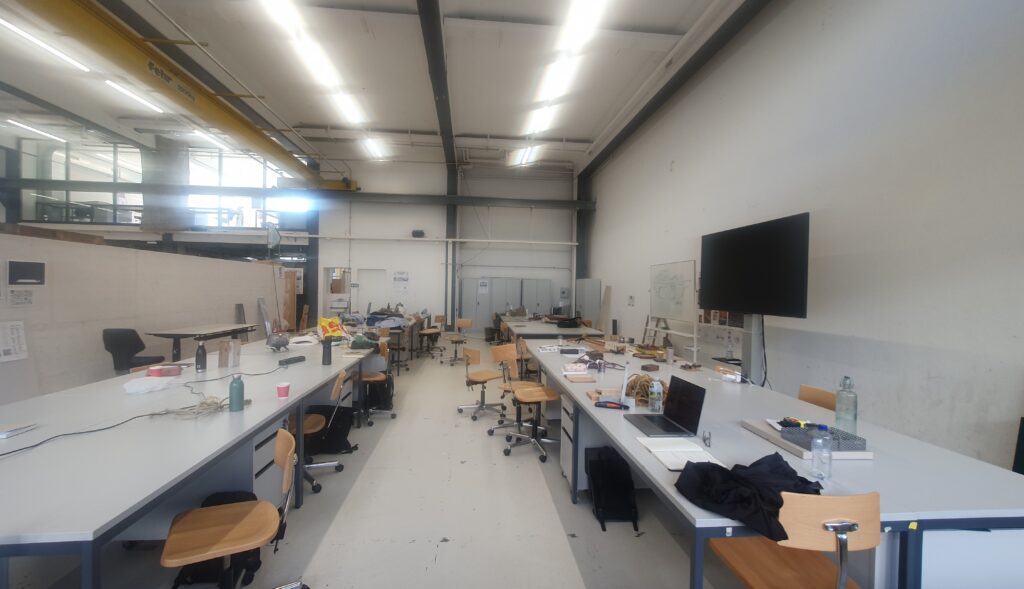

Basic geometry: rectangular plan / painted concrete floor / painted concrete ceiling
The main purpose of this space is to welcome all the 28 students from our design studio. It provides for each architecture student a place to work with individual desks.
This space is noteworthy in terms of acoustics because it’s an open space in a big ‘atelier’ where more than a thousant students are working on a daily basis, giving the space and sound an interesting and changing dynamic during the day.
It was pretty obvious for me to present the overall atmosphere of the space because I spend a lot of time there and the acoustic is really interesting, but not in the positive way. It really caught my attention. As I said many students work in this big open space and it makes the acoustic of our area pretty bad. It becomes uncomfortable and difficult to hear people talking a few meters away from you when the whole ‘atelier’ is full of students.
Acoustic events:
– When the overall ‘atelier’ is pretty empty and we have a presentation in our space it’s really difficult to hear properly the person talking. The voice is quickly reverb and not clear anymore.
– When someone makes something fall on the ground the sound is thumping.
– Every single movement or small noise is emplified when the room is empty, or at the opposite participate in the constant muddy sound when the room is full of people.
Using a daily language I would say that this place sounds like a huge box with sounds coming from all over the and from a lot of differences sources. It’s quite uncomfortable because the sounds are irregular. It’s like a mosquito flying around you and bizzing. And sometimes you have only one really strong sound like a bang or a thump, which can be surprising and not pleasant.
To close with this first case of study I would say that the acoustic is live, harsh and muddy.
Space 2: Amphitheater – ONA E7
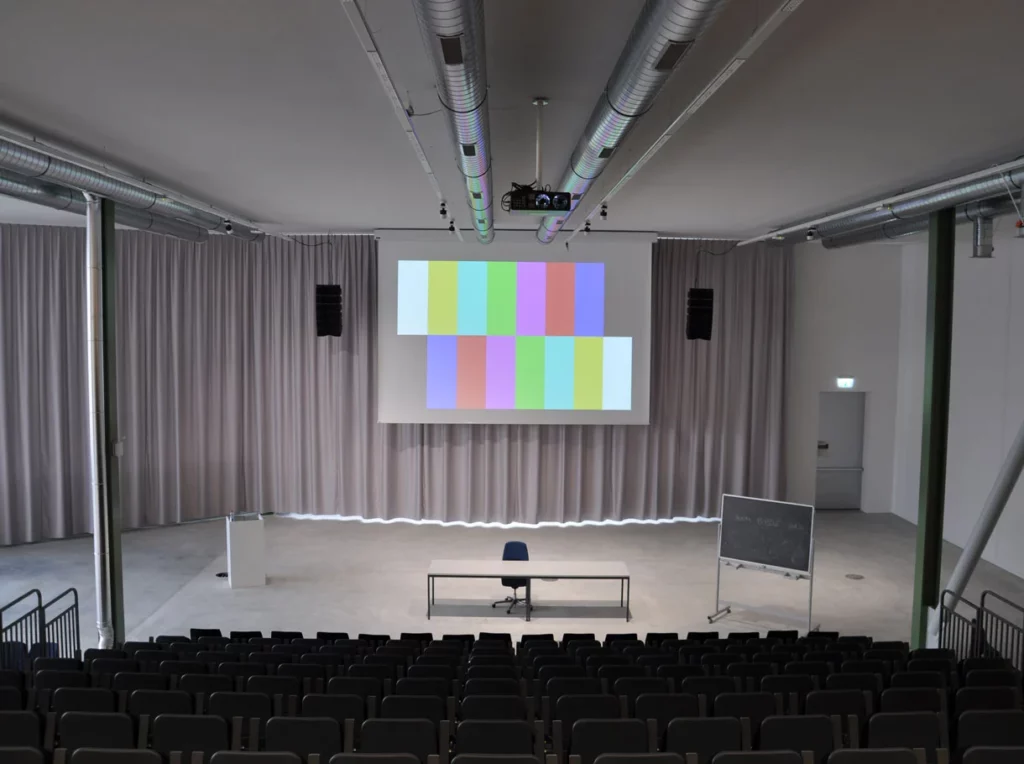

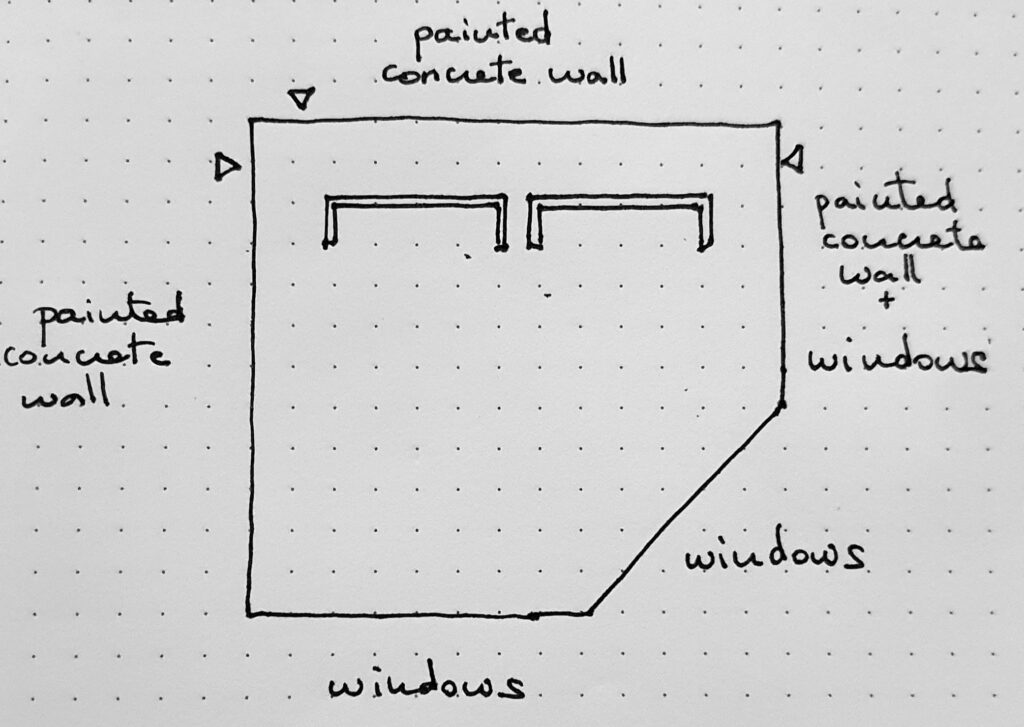
Basic geometry: pentagon with 4 right angles / painted concrete floor / painted concrete ceiling
The main purpose of this space is actually to be a free space for multiple uses like lectures, seminars, critics or even exams.
I think this place is noteworthy in terms of acoustics because it’s mainly use as an amphitheater even though the acoustic qualities are really poor, which I find odd and inadequate. That’s something we can directly see with the plan of the room and its geometry.
It’s mostly the overall atmosphere that catches my attention. Indeed during the courses we couldn’t hear properly the teacher who had to use a microphone to be heard. This created even more reverb and uncomfortable sounds in the whole room.
Acoustic events:
– If you clap, a loudly echo occurs but it’s hard to say where the reverb is made and how is the sound transferred.
– When a few people starts talking it creates a buzzing sound.
Using daily language I can say that this space could be seen as a big irregular box where a few sounds directly become noisy and disturbing.
To conclude on this space I would say that the acoustic in it is live, echoey and dull.
Space 3: A Living Room
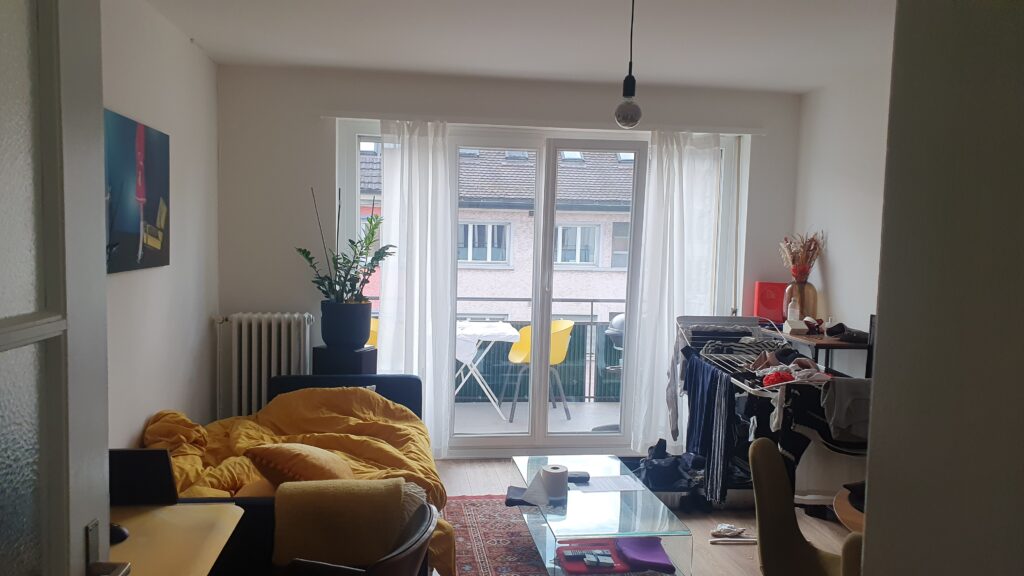

Basic geometry: rectangular plan / PVC vinyl flooring / painted concrete ceiling
The main purpose of this room is for having dinner, talking with people, reading, watching television or playing video games.
This space is interesting in term of acoustics because even though it’s a small and cosy room there are still some sounds that can be disturbing and annoying. Indeed in apartments we don’t really notice a lot of sounds that just become secondary.
What caught my attention is the difference between a normal day with the windows closed the space is almost silent; we can’t hear the neighbours, or the people walking upstairs. It creates a peaceful atmosphere as I said. But once we open the windows it completely changes. The clanging sounds from the city (bus, train, cars…) get into the living room. For example during the night it’s almost impossible to sleep with the windows open because of those irregular sounds.
Specific acoustic events:
– Having conversations with a few people creates a warm sound atmosphere.
– If you clap loudly, the sound is not reverberating at all and is well balanced.
Using a daily language I can say that this room is well isolated in an acoustic way. It feels like being in a soft small box when no harsh and disturbing sounds can occur while the windows are closed. Even the ding-dong from the door is heard as a quiet sound.
To conclude I’ll say that this room has a warm, lush and balanced acoustic atmosphere.
Exploring the Emotional Impact of Everyday Sounds
My New Bedroom
“This weekend I’ve just moved into my new flat. I’m getting to know the different rooms where I’ll be living, especially my bedroom. The first thing I notice is the deafening noise of the traffic in the street around my building. Obviously the windows are open, so I close them to make sure the noise is muffled. Fortunately, when the windows are closed, it’s as if the noise from the cars is muffled. However, another continuous sound disturbs my ear. I didn’t notice it during the day, but it was only in the evening when there was less traffic and the windows were still closed that I realised that the pipes running through my bedroom were emitting a continuous sound. It’s difficult to pinpoint the exact point of origin. It’s as if it invades the whole room. It’s the kind of sound you don’t notice until you’re paying attention, yet once you do it becomes omnipresent in the room. I thought I wasn’t going to be able to sleep because of it, but in the end the intensity was low enough that the ear got used to it very quickly and didn’t prevent me from falling asleep.”
“After spending several days in this new room, I no longer pay any attention to the noise. On the other hand, when I put my ear to it I can still hear it, but it has almost become comforting. I associate it with a place of safety, which is my bedroom. I wonder whether this noise, in another context where I wouldn’t feel as comfortable, wouldn’t have become unpleasant, even unbearable.”
RapLab ETH ONA
“Here I am, entering the model workshop at ONA to cut polycarbonate sheets. There’s no-one in the room and it’s dead silent. You can barely hear the many students chatting in the other room downstairs; I have the feeling that I’m entering a hermetically sealed box where neither outside sounds nor those emitted from inside can propagate. And yet I notice a box of Kies balls hanging on the wall… I start to prepare my piece to be cut and bring it in front of a very large machine; a band saw. I press the green activation button and WOOOM!
A deafening noise fills the room. It’s a surprise to me, but I still can’t bring myself to get some ear protection. The noise is still bearable. It’s intense but it’s not too high-pitched, so I can handle it pretty well. So I start cutting my polycarbonate board and there’s the second surprise, but even less bearable than the first; an extremely high-pitched, piercing sound fills the room and seeps into my ears. This time I decided to go and get the Kies balls and put them on, as the sound was almost unbearable. As soon as I finish cutting and stop everything, an almost Olympian calm returns to the room…”
“What a dichotomy I’ve just put my ears through. My body doesn’t quite understand this sudden change in sound level, and I soon start to get a foggy head and I feel that subconsciously I’ve been put under stress by the noise alone.”
Empirical and Numerical Estimation of Room Acoustic Properties
My New Bedroom – 1st Estimation
For this first estimation of the reverberation time RT60 using Audacity, I chose to do it in my new bedroom, in which I explored the emotional impact of the sounds for the second assignment.
Here in this screenshot you have an overview of different sounds I recorded standing right next to my laptop microphone, as a test and to get more comfortable with this new software:

In this screenshot you can see a few claps that I recorded standing 1m away from the computer’s microphone:

In this last screenshot I zoomed in the second clap moment to guess the reverberation time RT60 of the bedroom:

In my case : 30 [dB] decay in 0.18 [sec]
This corresponds to a reverberation time RT60 = 0.36 [sec]
Using the online calculator, the estimated reverberation time is:
- at 500 [Hz] = ? [sec]
- at 1000 [Hz] = ? [sec]
(for now the measures are not written because the online calculator doesn’t work…)
A Living Room – 2nd Estimation
For the second estimation of the reverberation time RT60, I chose to do it in the living room space I described in the first assignment, which is my brother’s living room.
In this screenshot you can see a few claps that I recorded standing 1m away from the computer’s microphone:

In this last screenshot I zoomed in on the second clap moment to guess the reverberation time RT60 of the living room:
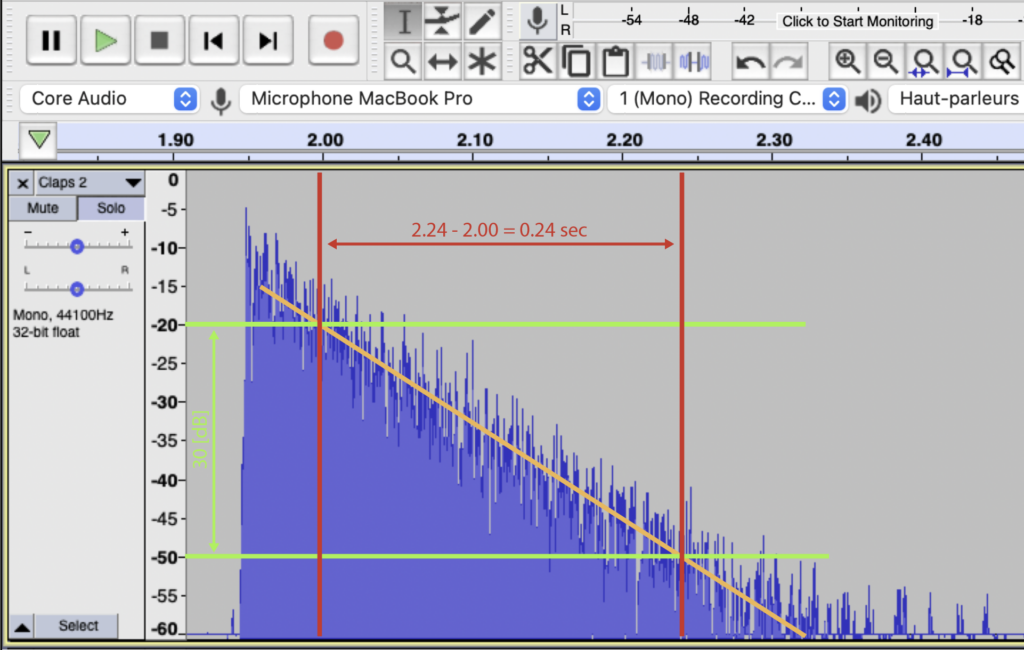
In my case : 30 [dB] decay in 0.24 [sec]
This corresponds to a reverberation time RT60 = 0.48 [sec]
Using the online calculator, the estimated reverberation time is:
- at 500 [Hz] = ? [sec]
- at 1000 [Hz] = ? [sec]
(for now the measures are not written because the online calculator doesn’t work…)
Characterization of Room Acoustic Treatments
My New Bedroom
Here you can see the plan of the room:
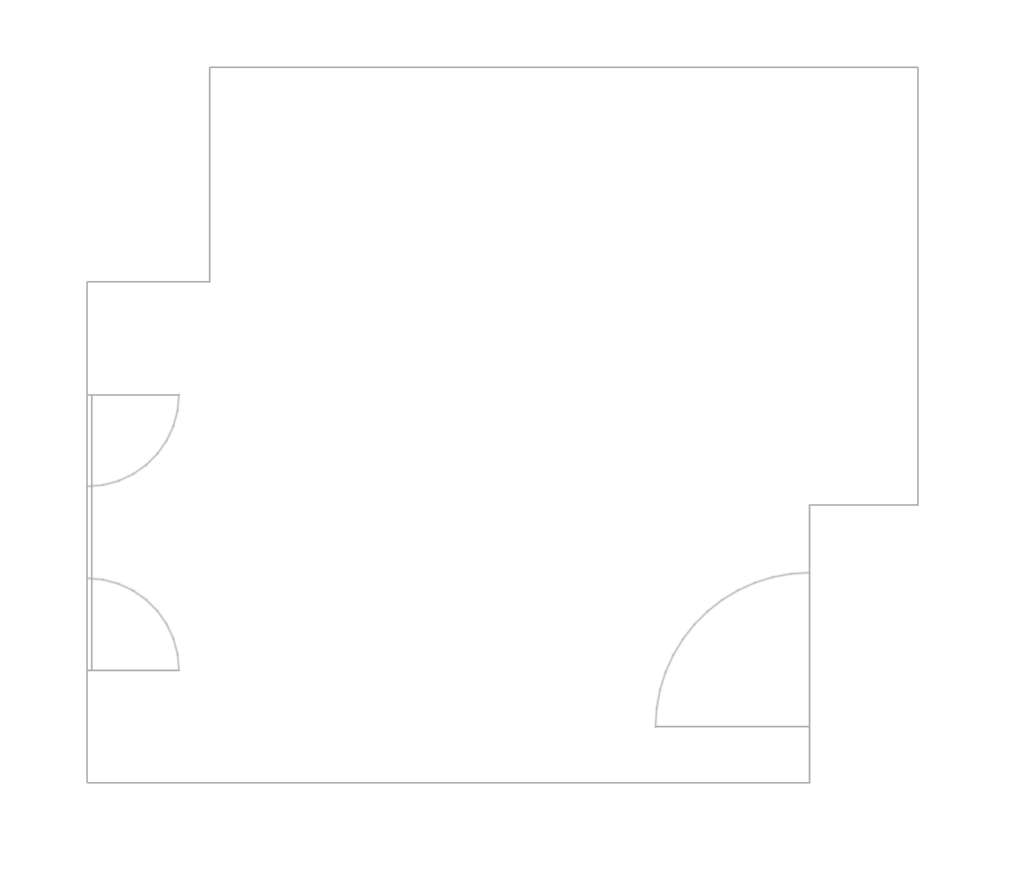
The floor has wooden parquet:
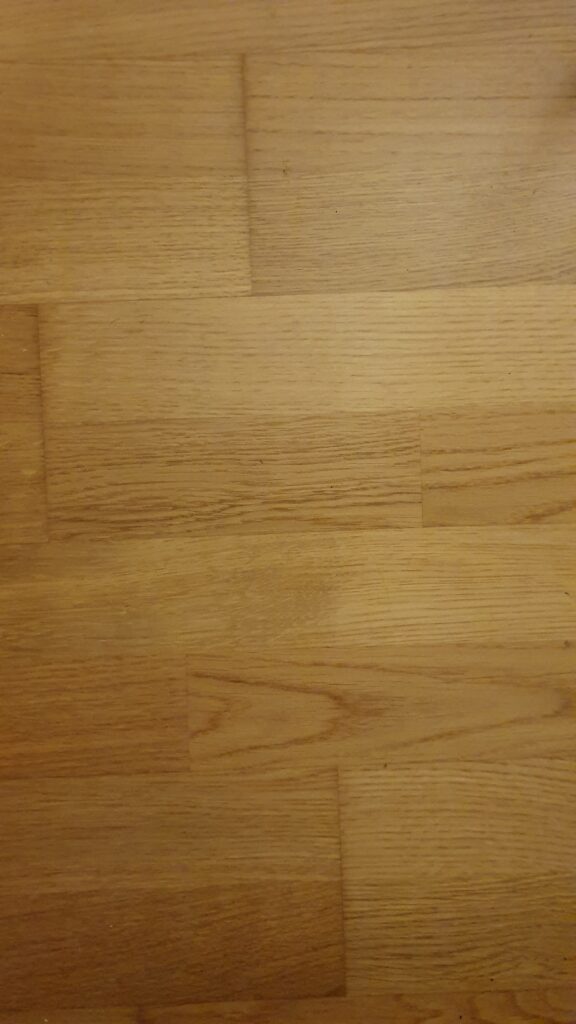
The walls are made of painted concrete:

The ceiling is also made of painted concrete:
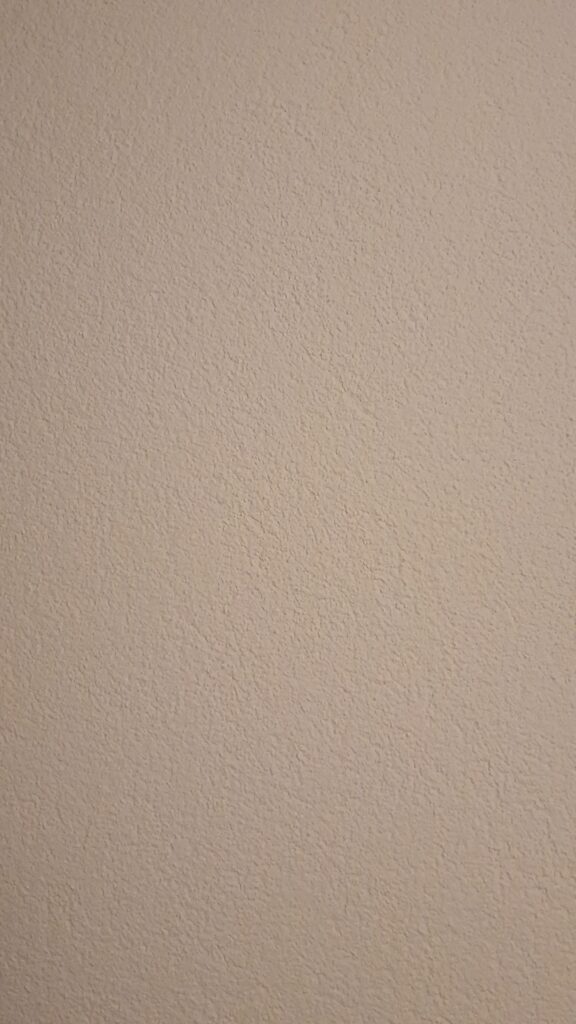
We have three small windows with no curtains:
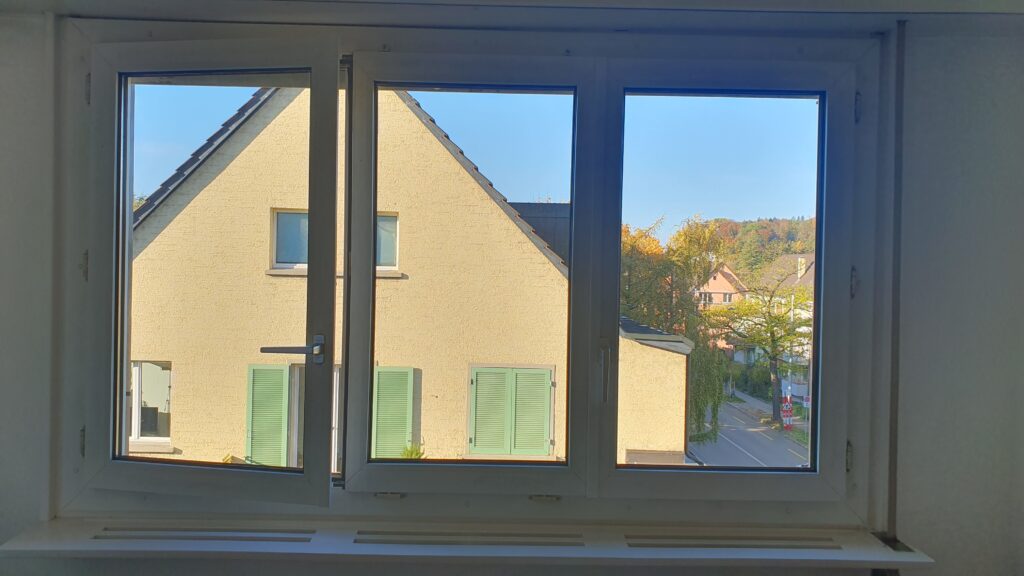
The door is made of wood:

About the geometry of the room and it’s materials:
The room is pretty basic and not so big, with an almost rectangular shape, with parallel surfaces. This will create some reflection, also because the walls, ceiling and floor are smooth and hard surfaces. The wall with the three small windows is particularly sound-reflecting comparing to the other walls.
About the sound absorbers:
There are no sound absorbers installed in the room, apart from the added furniture. The most important and interesting furniture to note are as follows:
- Bed with bed sheets
- Rectangular carpet
- Rounded carpet
- Wooden shelf
- Wooden dresser
In this list of furniture we can say that the bed with the bed sheets and the two carpets could be considered as absorbers. They will absorb higher frequencies. On the other side, the wooden shelf and dresser will scatter sound without much absorption, and so would favor the diffuse reflection of sound.
A Living Room
Here you can see the plan of the room:
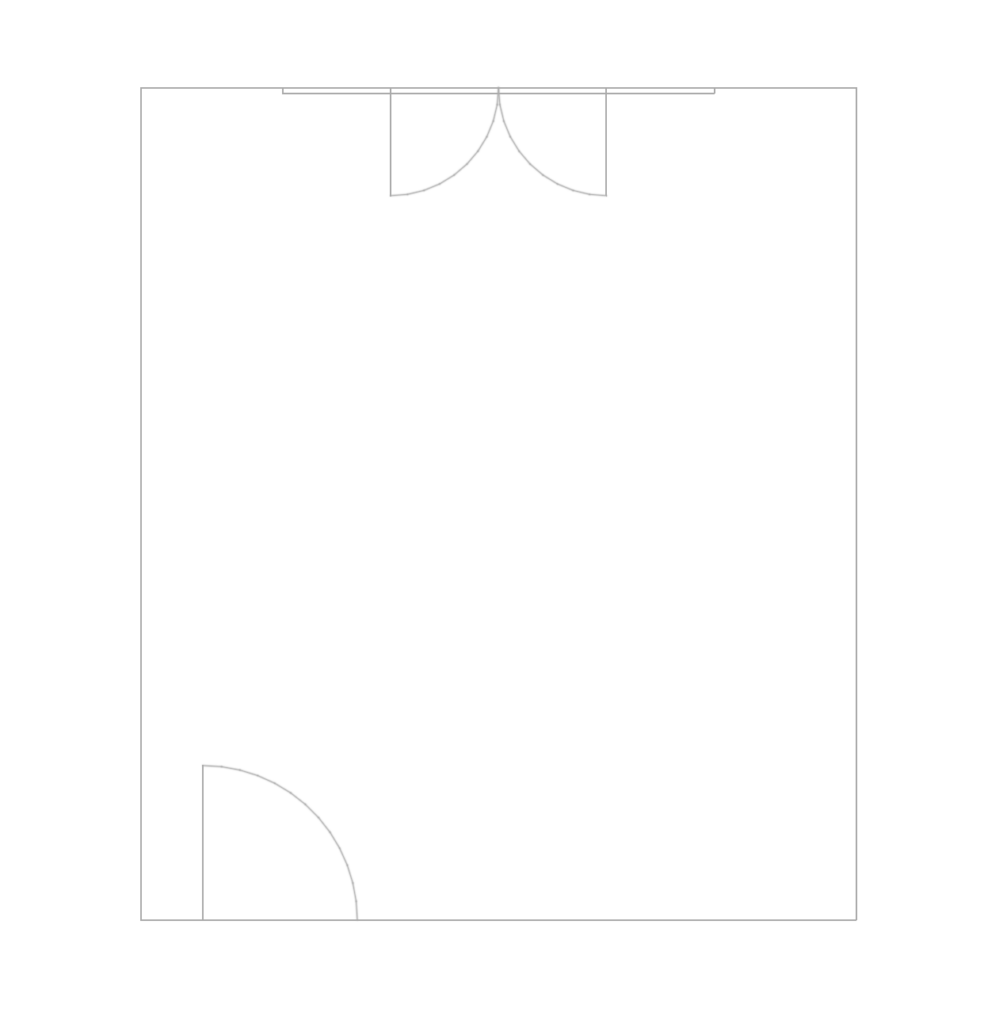
The floor is wood-effect vinyl:
…
The walls are made of painted concrete:
…
The ceiling is also made of painted concrete:
…
We have 4 big windows with curtains on one of the four walls:
…
The door is mostly glass with a wooden frame:
…
About the geometry of the room and it’s materials:
The room is pretty basic and not so big, with a perfect rectangular shape, almost a square. All the walls are parallels and there’s no concave/convexe surfaces. This will create some reflection, also because the walls, ceiling and floor are smooth and hard surfaces. The wall with the big four glass windows could be really sound-reflecting, but the curtains in front of it reduce a bit the reflection of sound in the room.
About the sound absorbers:
There are no sound absorbers installed in the room, apart from the added furniture. The most important and interesting furniture to note are as follows:
- Couch
- Carpet
- Thin wooden and metal shelf
- Thin wooden and metal dresser
- Thin curtains
- Glass coffee table
In this list of furniture we can say that the couch, the carpet and the thin curtains could be considered as absorbers. They will absorb higher frequencies. On the other side, the thin shelf, dresser and coffee table will scatter sound without much absorption, and so would favor the diffuse reflection of sound.



